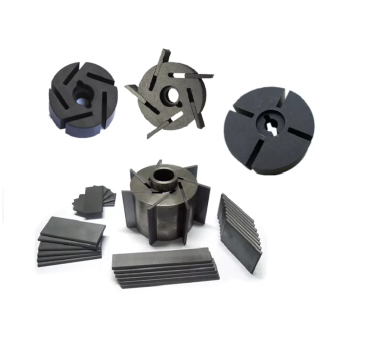A water pump is a liquid-carrying equipment that transports or presses liquids. Different types of water pumps have different uses, such as conveying water, sewage, and oil.
The liquid inside a water pump often needs to be transported under a certain pressure. Poor sealing of the water pump will lead to liquid leakage, reducing efficiency, increasing energy consumption, and even damaging equipment or causing accidents.
Therefore, it is particularly important to correctly install the mechanical seal for water pumps to prevent seal failures.
A mechanical seal is a commonly used sealing method in water pumps. It prevents liquid leakage from the high-pressure area to the low-pressure area.
How to Prevent Water Pump Seal Failure?
Choosing the right materials for a mechanical seal for water pumps that are suited for specific working conditions helps extend seal life. Accurate installation and proper maintenance are key to reducing water pump seal failures.
- Choose Appropriate Sealing Materials
The fluid pumped, pressures involved, and operating temperatures all influence wear on the seal faces. Consulting with mechanical seal ring experts helps determine the best performing and most durable materials matched to the specific environment.
For example, silicon carbide faces withstand corrosion and abrasion better than others when pumping acidic or corrosive fluid.
- Install and Test Correctly
Even the slightest deviations from the proper installation procedure of the mechanical seal for water pumps can cause early malfunctions under fluid pressure. It is essential to take time to carefully inspect seal components and ensure smooth, scratch-free surfaces.
Testing the water pump under usual load conditions before full deployment helps confirm no leaks from poor installation or misalignment.
- Avoid Dry Operation and High Temperatures
Heat generation from friction leads to accelerated aging without proper fluid lubrication. Operating a water pump dry for extended periods leads to the seal being worn. Similarly, excess heat degrades seal material properties over the long run if cooling is insufficient.
Adjusting liquid flow rate and maintaining temperatures within design ranges can slow seal degradation!
- Regularly Maintain and Inspect
Regular inspections allow faults to be caught before major impacts occur. For example, uneven temperature or pressure on the sealing face may cause deformation. Hot cracking occurs when the material cannot withstand temperature changes. Wear is common in mechanical seals, which can affect the flatness of the sealing surface.
Coking refers to the formation of carbides in materials at high temperatures. Corrosion refers to the reaction between chemical media and sealing materials, which weakens the strength of sealing components.
Checking for changes in the mechanical seal for water pumps catches small issues before they escalate and potentially cause unplanned downtime.
Attentions When Installing Mechanical Pump Seals
Replacing a worn mechanical seal for water pumps is critical for ongoing smooth pump operation. However, installation requires meticulous care. Here are some recommendations:
- Prevent Bumps and Scratches on Sealing Surfaces
Even tiny surface imperfections may potentially lead to leakage. Inspecting components under proper lighting helps spot any nicks or grooves that need repair before assembly.
The stationary ring and the rotating rings are the core components of the mechanical seal for water pumps. Gentle, scratch-free handling is necessary when fitting parts together to maintain ideal sealing interfaces.
- Keep the Sealing Surface Dry and Clean
Pay attention to cleanliness during replacement. Dampness or contaminants interfere with proper surface contact, allowing fluid to permeate and accelerate wear. Wiping parts dry using a lint-free cloth and cleaning mating areas aid in a tight seal.
- Ensure Uniform Force Distribution
Misaligned installation pressurizes one region excessively, possibly resulting in seal distortion or damage. Check the seal end after assembly, but confirm the balanced sealing before operation. Applying fixing devices protects long-term performance.
- Reinforce and Try to Operate after the Assembly
After installing the mechanical seal rings, ensure they can move flexibly on the shaft without excessive shaking. Sealing components can be reinforced by fixing screws or tools to ensure they do not loosen during operation.
Testing initial seal integrity under mild pump use before putting it into full service allows for timely correction.
JUNTY’s Rotary Seal Rings
Our brand, JUNTY, is well-known for providing durable sealing components and wear protection parts. We offer customized, high-quality rotary seal rings that match any application requirements. The rotary seal ring is commonly used as a mechanical seal for water pumps to prevent leakage. Our rotary seal ring boasts:
- Low Friction Ratio:We carefully select low-friction seal faces to reduce mechanical wear.
- High Impact Strength:Strong, durable seal materials like silicon carbide withstand shocks and vibrations to protect against impact damage.
- Exceptional Performance:Mechanical rings match the operating environment for reliable, long-lasting service life.
- Customizable:Our seal rings accommodate varied applications with various available seal materials.
- Superior Specifications:Our mechanical pump seals meet tight tolerances and surface finish standards.
Conclusion
By following proper maintenance procedures, selecting the right sealing materials, and carefully installing replacement seals, water pump downtime due to seal failure can be minimized.
JUNTY is committed to manufacturing durable and customizable sealing solutions for customers. Please feel free to contact us or check more mechanical seal products on our website to ensure the water pump’s long-lasting and hassle-free performance.





